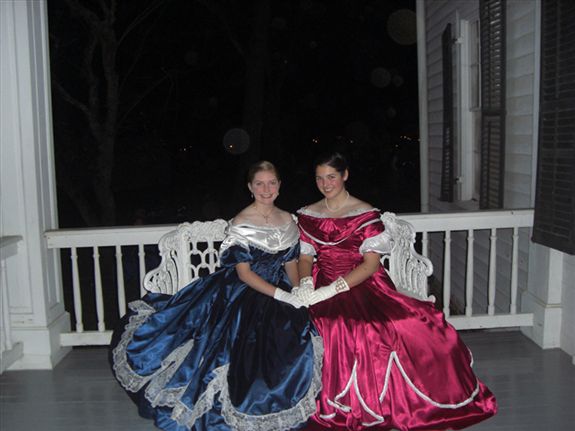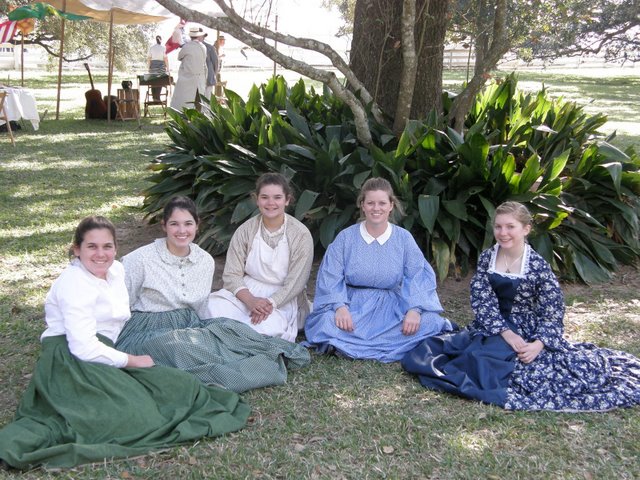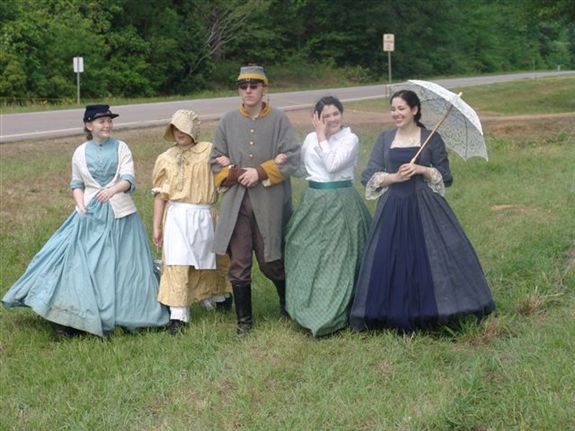|
Boots & Saddles | Uniforms of the 3rd | Weapons of the 3rd | Period Horse Tack | Hoop Skirts & Such Hoopskirts and Suchby Mary Clinch I have yet to meet a lady who has not at some point wished to be a Southern belle. From the moment we are introduced to Scarlett O’Hara in Gone with the Wind and her beautiful, swishing gowns we have a longing to try one on, see how it fits. This is where we ladies get to have fun in the world of reenacting. We are able to transform into the Southern belles we are deep in our hearts. My goal here is to introduce newcomers to women’s clothing of the Civil War period and to provide “continuing education” to those who are already members of the 3rd Texas. We want to provide the truest impression we possibly can for the benefit of the public who comes to visit our campsite.
3rd Texas Ladies displaying their Ball gowns. You may be familiar with the Godey’s Lady’s Book, a magazine started in 1830 and founded by Mr. Louis B. Godey. I find it amusing that a man founded the publication that became one of the greatest influences on women’s fashions in the 1860’s. You can visit the following link for more details of this monthly publication: http://en.wikipedia.org/wiki/Godey's_Lady's_Book. The magazine featured engraved fashion plates depicting the current styles of that period. The goal of these fashions was to make the waist look narrow and every piece of every garment worked to that end. When searching for the right dress, you can follow the basic guidelines below. There were three common bodice styles during the Civil War.
There were also three common styles of sleeves.
Please note: the only dress in which a lady’s arm was revealed was a ball gown. Two necklines defined the difference between a day dress and a ball gown.
You are well familiar with the long, wide skirts of the Civil War period dress. Though these skirts rarely touched the ground, it was important that they be long enough not to show a lady’s ankles. They were either pleated or fully gathered at the waist, which adds to the fullness of the skirt and the illusion of a narrow waist. I have yet to meet a lady who has not at some point wished to be a Southern belle. From the moment we are introduced to Scarlett O’Hara in Gone with the Wind and her beautiful, swishing gowns we have a longing to try one on, see how it fits. This is where we ladies get to have fun in the world of reenacting. We are able to transform into the Southern belles we are deep in our hearts. My goal here is to introduce newcomers to women’s clothing of the Civil War period and to provide “continuing education” to those who are already members of the 3 rd Texas. We want to provide the truest impression we possibly can for the benefit of the public who comes to visit our campsite. You may be familiar with the Godey’s Lady’s Book, a magazine started in 1830 and founded by Mr. Louis B. Godey. I find it amusing that a man founded the publication that became one of the greatest influences on women’s fashions in the 1860’s. You can visit the following link for more details of this monthly publication: http://en.wikipedia.org/wiki/Godey's_Lady's_Book. The magazine featured engraved fashion plates depicting the current styles of that period. The goal of these fashions was to make the waist look narrow and every piece of every garment worked to that end. When searching for the right dress, you can follow the basic guidelines below. There were three common bodice styles during the Civil War.
There were also three common styles of sleeves.
Please note: the only dress in which a lady’s arm was revealed was a ball gown. Two necklines defined the difference between a day dress and a ball gown.
You are well familiar with the long, wide skirts of the Civil War period dress. Though these skirts rarely touched the ground, it was important that they be long enough not to show a lady’s ankles. They were either pleated or fully gathered at the waist, which adds to the fullness of the skirt and the illusion of a narrow waist.
Some of the 3rd Texas ladies in their day dresses.
3rd Texas ladies enjoying a stroll in their hoop skirts.
|








 The “V” Bodice – This bodice is more fitted. It was becoming fashionable when the war started and was the most popular style by the time the war ended. You can see an example of this style in Figure 1 to the right.
The “V” Bodice – This bodice is more fitted. It was becoming fashionable when the war started and was the most popular style by the time the war ended. You can see an example of this style in Figure 1 to the right. Day Dress – More often than not the necklines on a day dress extended to the base of the neck and were completed with a removable collar. Being removable made the collar easy to remove for cleaning and replacement. Figure 2, to the left, illustrates this type of neckline with a short, stand-up collar.
Day Dress – More often than not the necklines on a day dress extended to the base of the neck and were completed with a removable collar. Being removable made the collar easy to remove for cleaning and replacement. Figure 2, to the left, illustrates this type of neckline with a short, stand-up collar. The “V” Bodice – This bodice is more fitted. It was becoming fashionable when the war started and was the most popular style by the time the war ended. You can see an example of this style in Figure 1 to the right.
The “V” Bodice – This bodice is more fitted. It was becoming fashionable when the war started and was the most popular style by the time the war ended. You can see an example of this style in Figure 1 to the right. Day Dress – More often than not the necklines on a day dress extended to the base of the neck and were completed with a removable collar. Being removable made the collar easy to remove for cleaning and replacement. Figure 2, to the left, illustrates this type of neckline with a short, stand-up collar.
Day Dress – More often than not the necklines on a day dress extended to the base of the neck and were completed with a removable collar. Being removable made the collar easy to remove for cleaning and replacement. Figure 2, to the left, illustrates this type of neckline with a short, stand-up collar.
